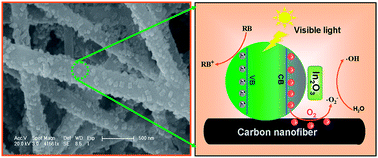In2O3 nanocubes/carbon nanofibers heterostructures with high visible light photocatalytic activity
Abstract
One-dimensional In2O3 nanocubes/carbon nanofibers (CNFs) heterostructures have been successfully obtained by a simple combination of

* Corresponding authors
a
Center for Advanced Optoelectronic Functional Materials Research, and Key Laboratory of UV Light-Emitting Materials and Technology of Ministry of Education, Northeast Normal University, 5268 Renmin Street, Changchun, People's Republic of China
E-mail:
clshao@nenu.edu.cn
Tel: +8643185098803
b Department of Chemistry, Northeast Normal University, 5268 Renmin Street, Changchun, People's Republic of China
One-dimensional In2O3 nanocubes/carbon nanofibers (CNFs) heterostructures have been successfully obtained by a simple combination of

 Please wait while we load your content...
Something went wrong. Try again?
Please wait while we load your content...
Something went wrong. Try again?
J. Mu, C. Shao, Z. Guo, M. Zhang, Z. Zhang, P. Zhang, B. Chen and Y. Liu, J. Mater. Chem., 2012, 22, 1786 DOI: 10.1039/C1JM13577E
To request permission to reproduce material from this article, please go to the Copyright Clearance Center request page.
If you are an author contributing to an RSC publication, you do not need to request permission provided correct acknowledgement is given.
If you are the author of this article, you do not need to request permission to reproduce figures and diagrams provided correct acknowledgement is given. If you want to reproduce the whole article in a third-party publication (excluding your thesis/dissertation for which permission is not required) please go to the Copyright Clearance Center request page.
Read more about how to correctly acknowledge RSC content.
 Fetching data from CrossRef.
Fetching data from CrossRef.
This may take some time to load.
Loading related content
